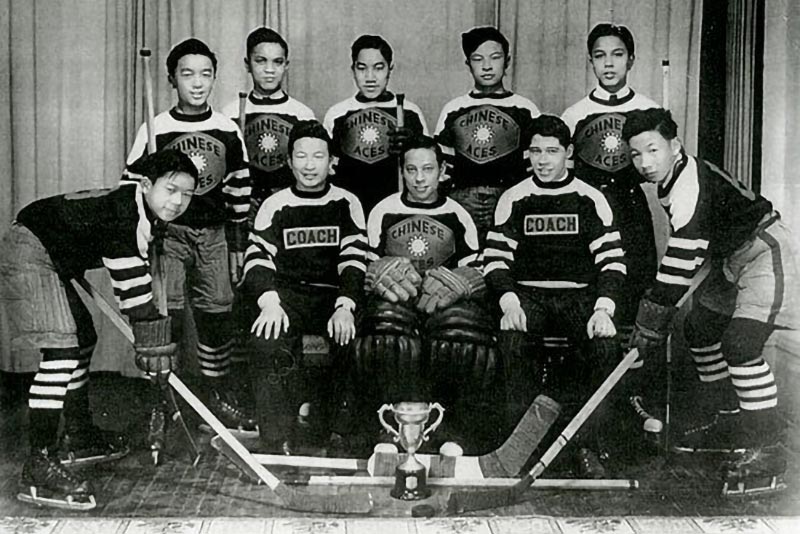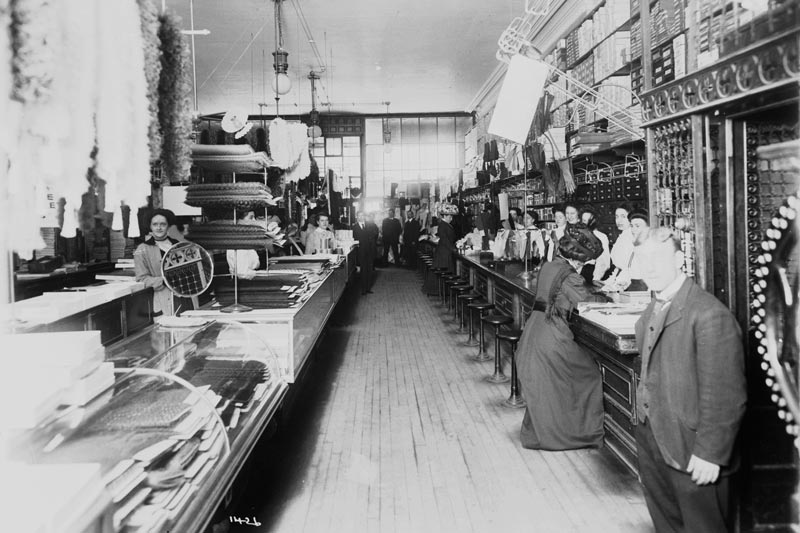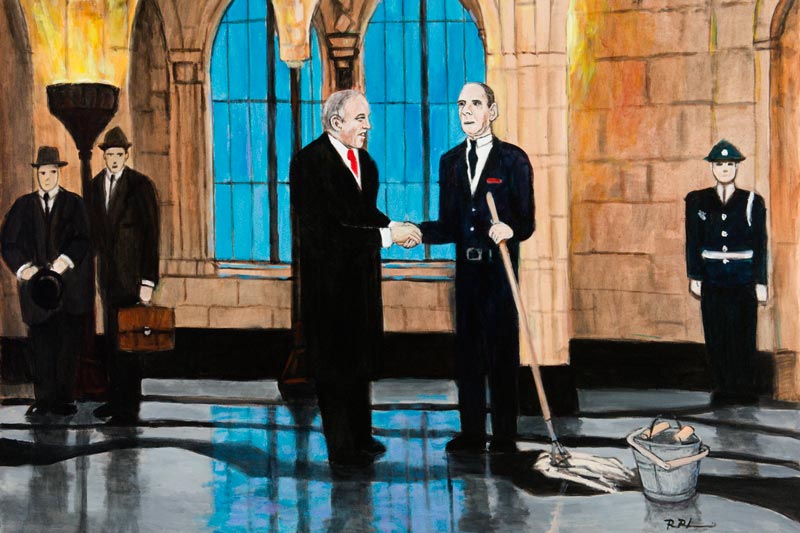2020: Working in Ottawa


This painting by Ottawa artist, Ross Rheaume, imagines a day in the life of the Carleton County Gaol on Nicholas Street in the late 19th century. The jail housed men, women and sometimes children imprisoned for a variety of crimes. Inmates were put to work and here we see men chopping wood and shoveling snow while women sew inside. The Gaol operated between 1861 and 1972.
Credit: Carleton Centre for Public History Painting and Photo: Ross Rheaume

Ironing Room, Home for Friendless Women, c. 1916. Between 1887 and 1939 the Home for Friendless Women provided a safe and supportive refuge for unwed mothers, abandoned women, and those seeking help to escape addiction, abuse, and prostitution. To raise revenue, the Home offered a laundry service employing the women in washing, drying, and ironing clothes for the price of thirty cents per dozen articles.
Credit: William James Topley / Library and Archives Canada / PA-011264

Established in 1941, the Chinese Aces were Ottawa’s first all Chinese-Canadian hockey team and players included Glebe grocery store owner Shing Wong’s son Leslie and some of his classmates. The Aces won the cup in 1946 defeating their rivals, the highly ranked Aylmer Saints, by five goals to four.
Photo courtesy of https://livesofthefamilies.wordpress.com

Lansdowne Park was used by the Canadian Armed Services during both World Wars as a barracks and a training ground. This recently re-discovered painting by prominent artist Orville Fisher depicts workers repairing a truck in the Aberdeen Pavilion.
Credit: Orville Fisher Fifth Wheel Assembly: M.T. Garage and Workshop, Machinery Hall, CWM 19710261-6480, Beaverbrook Collection of War Art, Canadian War Museum

This photo shows Ottawa hospital laboratory workers hosting Canada’s Governor General on a visit to the newly opened facility at Ottawa Hospital in the 1960s. Most laboratory workers were women and they performed essential work facilitating blood work at the hospital.
Photo courtesy of Sharon Argue

Nurses at the Ottawa Civic Hospital tend to a patient in 1926. Replacing three older hospitals at a cost of $1,500,000, the Ottawa’s new Civic Hospital opened in 1924 with 550 beds. This photo is one of a small collection taken to celebrate the event.
Credit: City of Ottawa Archives, Civic Hospital Collection, COA 2465

Peddler Saul Tanner with horse and cart, c. 1923. Many peddlers chose to live in and around Byward Market, due to its proximity to goods and produce such as fresh fruit and vegetables. In addition to groceries, peddlers carried everything from toiletries to home furnishings, or collected items such as old rags or scrap metal for resale.
Credit: Ottawa Jewish Archives 1-714-03

This photo was one of a series taken at the Royal Canadian Mint on Sussex Drive in April 1909. Here we see workers cleaning newly minted coins.
Credit: William James Topley Library and Archives Canada / PA-009645

Edmondo Inconditi began his apprenticeship with a cobbler after dropping out of school. He immigrated to Alta Vista in 1966 and has owned Paris Shoe Repair since 1973. Today, Inconditi is one of the last remaining true cobblers in the city.
Credit: Photo courtesy of Caroline Forcier-Holloway of Edmondo Inconditi in his shop in 2015

Ottawa’s Lacrosse Team, June 13th, 1891. A year after this photograph was taken, the Ottawa’s lacrosse team amalgamated with the Ottawa Capitals and played in the majors under that name. Their rivals were teams from Montreal, Cornwall, and Toronto. Lacrosse was the most popular working people’s sports in nineteenth century Ottawa.
Credit: William James Topley Library and Archives Canada / PA-012354

Electric streetcars were first introduced in Ottawa in 1891 offering faster travel to and from work and new leisure opportunities such as Britannia trolley park where for a 5-cent fare workers and their families could enjoy a day out in the country. Here we see a Bank Street line car, c. 1900, outside the Langevin Building on Wellington Street.
Credit: William James Topley Library and Archives Canada / C-002460

After returning from the First World War decorated with a Victoria Cross, Filip Konowal eventually found work as a janitor on Parliament Hill. When Prime Minister W. L. M. King encountered Konowal wearing the crimson ribbon of the Victoria Cross he promoted him to the position of Personal Custodian to the Prime Minister’s office. Their meeting is captured in this painting by artist Ross Rheaume.
Credit Ross Rheaume

Opened by John Murphy and Samuel Gamble on Sparks Street in 1909, the Murphy-Gamble department store was well known for its unique system of bringing products down from upper shelves or distributing order forms and receipts via wire cables. It ceased independent operations in 1971. Floor workers were predominantly women, while men were the managers.
Credit: William James Topley / Library and Archives Canada / PA-009090

In the nineteenth century, millinery was one of the few skilled occupations available to women. Mrs. Rutledge, pictured above, opened her millinery shop at 140 Bank Street in 1913.
Credit: Andrews-Newton Photographers, Mrs. Rutledge’s Millinery Shop at 140 Bank Street, Ottawa, 1913, photograph: silver gelatin, Bytown Museum, P2773a
Many of the images and stories chosen for this calendar relate to earlier projects of the Workers’ History Museum whose mandate is to tell little known stories about workers and working life in Ottawa:
Ottawa 2017: Capital History Kiosks (January, April, May, September, November) a WHM project in collaboration with the Carleton Centre for Public History, Chapter One Studio and artist Ross Rheaume. Researched by Carleton University MA in Public History students supervised by Professor David Dean. You can learn more about each of these stories at the Centre for Public History’s portal: capital history.ca. The images and stories for February, May, and July were researched by WHM volunteers Jane Harkness and David Dean.
Bank Street: Ottawa’s Main Street (March, June, October, and December) a WHM project in collaboration with the Carleton Centre for Public History and Know History, researched by Emily Keyes.
Shoemakers and Cobblers: (August) part of an ongoing WHM oral history project about changing working lives in Ottawa.
Thank you to Caroline Forcier-Holloway, Sharon Argue, Denise Steeves and Denise Chong for allowing us to use their photos.
